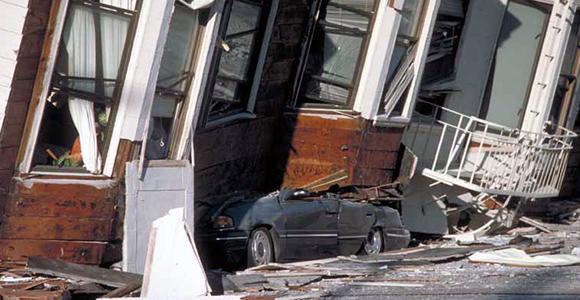Knowing two ways out can save your life in more instances than fleeing a fire.

J.K. Nakata, U.S. Geological Survey
You awaken in the middle of the night to the sound of your smoke detector. As you roll out of bed, your heart begins to race and panic sets in. You smell smoke.
You are at the office and suddenly hear gunfire. Screams fill the air--this cannot be happening.
The ground shakes. As you realize what’s happening, items begin to fall from the shelves and you hear the sound of car alarms. Your mind is racing. All you can think is, “What should I do?”
When seconds count, and your life and the lives of your family, friends, or coworkers are on the line, what you do next can make all the difference. One of the first things you need to consider is, “How can I get out?”
I was living in San Francisco when the 1989 Loma Prieta earthquake struck. Prior to that day, I had experienced many tremors that proved to be no cause for serious concern. So I was surprised when the earthquake hit at 5:04 pm and shook the ground for the next 15 seconds. In the aftermath of the quake, the images of misshapen buildings, fires, the blacked out Marina District, and the collapsed Oakland Bay Bridge became etched in my mind. I was not aware how deeply I was affected until I happened to visit the Snowbird Ski Resort in Salt Lake City about six months after the earthquake. I was in the gift shop when the aerial tram descended into the lower terminal to drop off its riders. When the tram came to rest within the building, it briefly shook. Without hesitation I ran to the nearest exit, thinking there was an earthquake. As the logical side of my brain took over, I realized what I was doing and stopped. As embarrassed as I was, I was surprised to discover that I was not alone; at least one other guest had also run toward the exit.
The idea of getting out may sound simple, but experience has shown nothing could be further from the truth. Fire prevention also emphasizes the importance of having two ways out. The location of a fire, shooter, crowds, or other obstruction or emergency could prevent you from using your usual exit. At the Station Nightclub in 2003, the fire took only 5 ½ minutes to kill 100 people and injure another 230, as concert goers rushed toward the main entrance. Unfortunately, they were unaware of three other exits that could have been used.
Knowing two ways out can save your life in more instances than fleeing a fire. The video link provided below is a Department of Homeland Security grant-funded project that emphasizes making the decision to run, hide, or fight when confronted with an active shooter. Being prepared, thinking about your possible actions, and finding escape routes NOW could make all the difference between living through the incident or becoming a statistic.
- Learn more about the Station Nightclub fire and fires that occurred in other nightclubs and assembly locations from the National Fire Prevention Association.
- For more details on surviving an active shooter event, watch Run. Hide. Fight. Surviving an Active Shooter Event on YouTube. As the video explains, “It may feel like just another day at the office, but occasionally life feels more like an action movie.” Now close your eyes. Can you identify two exits out of your house? Can your children get out if the stairway is blocked or filled with smoke? If a shooter walks through the front door, will you run, hide, or fight? And if you run, how will you get out?
Last updated: October 13, 2016
